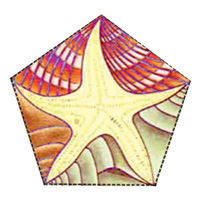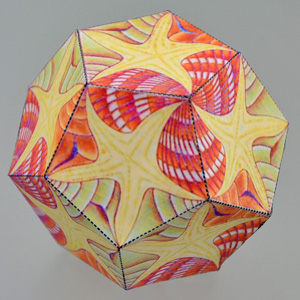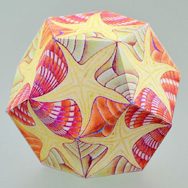

Develop spatial imagination
0.00 $
0 item(s)
Escher mosaic polyhedra
With the same pattern repeating on each polyhedrons face, it is possible to create an alternating combination of patterns on a three-dimensional geometric solid.
One of the first who plunged into the study of symmetry properties and its application in art was the Dutch graphic artist Maurits Cornelis Escher.
Escher is known for his conceptual lithographs, wood, and metal engravings, in which he masterfully illustrated the concepts of symmetry, infinity, and psychological perception of complex three-dimensional objects.
Ideas for his paintings Escher took from the exact sciences, from mathematics and geometry.
In 1936, he became interested in mosaics and regularly used it to fill the pictures plane.



The photos show the assembly sequence of the dodecahedron (step by step instructions on how to glue a paper polyhedron):
First, glue the two parts into a single net.





In Maurits Escher, there are followers who, like him, come up with original drawings. For us, the most interesting are those that allow the use of bulk geometric shapes.
For example, on the website of the Canadian University (SFU), drawings and sweeps were proposed to create five regular polyhedra. The images of animals and clowns are used as a repeating mosaic pattern:

Popular
Metal processing is a very complex process. But some masters can cut out polyhedrons from metal...
Make the New Year's holiday beautiful and unusual, so that the children saw in him a fairy tale,...
According to some spiritual teachings, a polyhedron already familiar to us — a compound of two...
A polyhedronis a solid bounded by flat polygons, which are called faces....
Which geometric solid known to us has the greatest strength? Which is most resistant to external...
Young British designer, Richard Sweeney, creates amazing paper sculptures. Interestingly, regular...
Want to make a fairly complex geometric solid - torus in 10...








